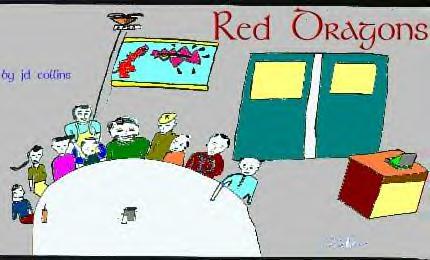

|
Christianity came to the Celts according to them shortly after Christ's
execution. The bearer of the cross was Joseph of Aramathea who planted his
staff at Glastionburry Abbey and there grew a great tree. The road to prominence and acceptance by the pagans in Rome was long
and painful. There is no evidence in Celtic lands of any of the purges
that Rome undertook. At the close of the Roman period Christianity was the
official religion of the Empire and was in Briton well rooted in Joseph's
tree. Yet according to the legend, the people particularly in rural Briton
outside of direct Roman control clung to the old ways. If we posit a reign for Arturo (La Arturus, Eng Arthur) at around
500AD, Arthur stands at the crossroads between Christian medieval Europe
and its pagan predecessors. The legend as retold in the epic form curious
expresses Celtic dualism at its height. Arthur though a Christian Knight
permits, engages in, sanctions and protects the Old Ways. The Celtic religion was pantheisistic. As in the natural religion of
the Greeks, Gods stood for the forces of nature or the seasons of life.
Consistent with the pagan view that the national Gods were
interchangeable, Caeser in analyzing the Celtic religion used the
corresponding names of the Greco-Roman pantheon. Yet among the Celts the
two principal Gods were the God of light and the God of darkness who did
battle at the Samheid (Holloween) and the Solestice, with the God of
darkness prevailing. It would be wrong to think of the Celts as practising an entirely
peaceful religion in harmony with nature. Celts would offer spectacular
human sacrafices by ensconcing victims in a tower of wood and lighting
them ablaze. However, by the time of the fall of Rome these Celtic
amusements had been taken over by their enemies the Saxon.
|
||
|
In the general view of the epic Mhwrlyn (La Merlinicus, Eng Merlin)
symbolizes the permanence of the old natural religion, its symbiosis with
the land and the seasons of life, its pragmatism, romanticism and its
values. But of course there is an important contradiction. Merlin is not
completely one with 'the old ones' or the Celts. He is the Roman Gaius
Caius Merlinicus Britanicus, high advisor to king and council filling a
role Romans occupied in the contemporaneous upstart courts of the Franks
and Goths. In the children's versions of the legend, Merlin gets younger
over time, emblematic of the endurance of the Old Ways in face of invasion
by Christians and the Barbarians. Merlin is said by many accounts to be a Druid, a keeper of the letters
and of the secrets (Runai). Fearing nationalistic tendencies, the Romans
had persecuted the Druids in Gaul, but the Roman hold on the Brythonic
countryside was by no means as firm as on the continent. Druids served as
the priest-scholar-advisors of the petty Celtic kingdoms. Gawain is often taken as the representative of the Christians. His
shield symbolizes the new Christian 'mythology' in the form of the pagan
Pentagram. Christianity introduced a new element into Celtic Society. Its unitary
rationalistic God challenged the Celtics in their magic world of seasonal
paganism. The original Christians who started the Celtic Church
softpeddled the changes, but as Christianity grew in strength toward the
end of the Imperium, a new stricter form of Christianity which would have
divorced the entire pagan past began its onslaught into the Islands. In many accounts of the legend Gwainahara (Fr Angl-Fr Guinevere, Eng
Gwenavive) is pictured as a virtuous Christian lady adhering to a stricter
version of the new religion which is invading the islands. Her love for
Lochanbar (Eng Lancelot), also a Christian, is part of the conflict within
herself. The tragedy in triumph would not be complete without this
important sub-element in the myth. Lancelot's name tells it all. It's probably a transliteration of
Lochanbar or loose sword. The legend teaches that in every virtue inheres
a vice. Courage mutates into aggression; recognition into jealousy; love
into hatred. In the adventure stories spun off the epic legend, the Knights when not
battling the barbarians seek the grail. What the grail is varies from
author to author. In some it is a cup, either the wine cup from the Last
Supper, a cup of Christ's blood or the cup of vinegar used to quench
Christ's thirst on the cross. The grail itself was long a pagan symbol. As a cup, the grail may
represent replenishment of the ever-abundant earth. Joseph Campbell
teaches that symbols recycle over time. Could it be that the horn of
plenty in the American Thanksgiving myth is the grail in disguise? Not all accounts of the legend make the grail a cup. In some versions
the grail is the veil of St Veronica who according to Christian legend
wiped Christ's face with her veil on the way to Calvary. Some Masonic
writers use this facet of the legend to claim an ancient connection of
Freemasonry both to the roots of Christianity and to the pre-Christian
pagan Celts, no doubt with quite a bit of the mental magic of Celtic
duality at work. | |||
|
| |||
| Arthurian Index Introduction to the Legend Life and Times of Arthur Masons in The Arthurian Legend Legacy of The Legend |
And for a few chuckles visit the SocWebb: Rockaway Park Philosophical Society Home Pages Cherio Fullosia Press | ||
| EMAIL: Dean of RPPS
| |||